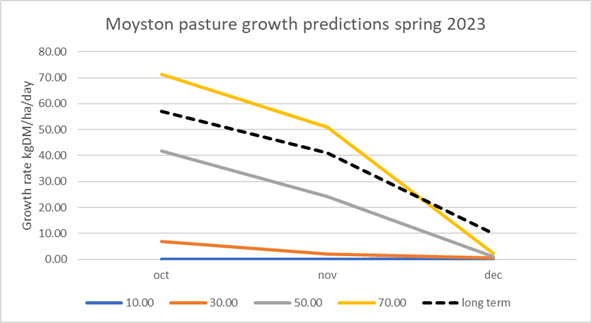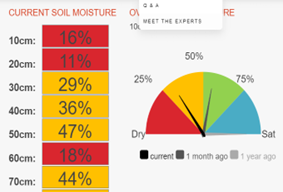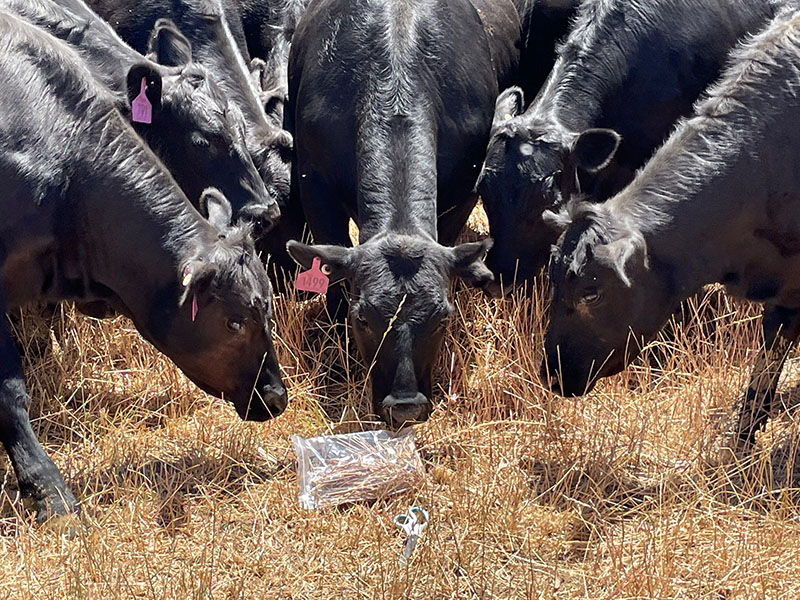Case study: Making decisions early in 2023 – Rob Cooper, Manager Barton Station
Rob Shea, Perennial Pasture Systems
Background
Perennial Pasture System (PPS) has an ongoing soil probe network providing daily readings of soil conditions – temperature and moisture at 10 cm increments to 80 cm. The information from these and other spoil probes is available on the Agriculture Victoria soil probe network site extensionaus.com.au/soilmoisturemonitoring/.
To investigate if they could add value to the information provided and get some early warning of spring seasonal conditions, PPS obtained funding through the Australian Government ‘Smart Farms Small Grants Round 3’ program (2021). This provided funds to get pasture growth estimates on 3 of their sites through spring. In 2023, they gained further funding from a Wimmera CMA Landcare Victoria grant to continue the project.
This article outlines the experience at one of the sites that used the information to make some early decisions, noting that the ‘drier than average’ or ‘El Nino ’conditions did not eventuate for much of the state.
What we did
Early in spring, Agriculture Victoria generated predicted spring pasture growth rates for 3 PPS sites, using initial pasture and soil moisture conditions with historic climate data. The seasonal forecasts were used as an indication of likely scenarios for the spring season. This was done using ‘GrassGro’, a CSIRO software program that uses extensive soil, pasture, animal and climate data to generate pasture growth rates on the farms involved.
At the previous 2 years, the spring seasonal conditions across the PPS region had been very good with full soil moisture profiles at the start of spring in 2021 and 2022 and forecasts for above average rainfall. Therefore, in these years predictions for spring were for both above average growth rates and for a prolonged growing season – which occurred.
In 2023, an early easter autumn break set up the year as one of the best years on record. However, by late August the conditions across some of the sites were quite different.
While 2 of the sites were depleting in moisture (Tottington and Stawell), they still had potential to have an average (or above) spring if they got good rainfall. The outlook at the Moyston site (Barton station) indicated that pasture would cease growing without good rains soon.
Barton Station
Rob Cooper is the manager at Barton Station Moyston, 20 km west of Ararat, near the Grampians. Barton Station is part of the Paraway Pastoral Group and consists of 8,244 ha with a 26,000 composite breeding ewe flock. In recent years a 3,000 mob of Angus breeders has been added to the operation.

In the past decade, Rob and his team have increased the carrying capacity of Barton through old pasture rejuvenation, establishing new pastures especially lucerne, extensive use of silage and paddock subdivision to refine the pasture rotations. Rob said the addition of cattle was the final piece of the program adding grazing pressure where needed and providing a separate source of income with yearling steer turn off.
It had been a good season until September, and Rob had taken the opportunity to trade in ewes, cows and weaner steers to use autumn/winter feed. Things dried up in September and Rob estimated pasture growth was only 60% of average. In the September report the profile was much drier than other sites with very low soil moisture in the top soil and also less at depth than at other sites (Figure 8).

The report indicated that significant rains were required soon (higher than long term average) to get good growth rates for the rest of spring, or at least close to average to get more growth (Figure 9). So in September, there was still time for a large rain to revive the spring growth but this wasn’t a high probability.

By October, rainfall had not occurred, the profile had dried further (Figur 10), and pasture predictions were for well below spring averages (they needed 30 mm of rain within seven days to achieve this). They had plans in place for this situation and implemented them after the first report confirmed expectations for the rest of spring.


Sounds like a plan
This galvanised Rob’s thinking and he correctly judged the weather patterns wouldn’t deliver a large rain in time. Rob commented he was fairly confident in his decision-making, but the report gave him the extra confidence to make the large alteration to the timing of stock selling. Old ewes were moved on a week after their lambs were weaned. There were also 1,300 young cattle to be sold and the Wagyu cross mixed-sex and Angus yearlings were immediately listed on the market. The focus was then on getting weight on breeding stock and setting up for a dry summer.

All this was done while there was still a small chance of a big spring rain and some further spring growth. However, Rob’s management is not based around small chances. ‘Hope is not a strategy’ he said, recalling that advice from a mentor in his early farm management days.
After the livestock sales, the focus turned to weaner sheep and cattle and feeding plans were made to get them to thrive through the summer and autumn and grazing plans for breeding stock were implemented.
PPS asked Rob, ‘What happens if it starts raining again?’ Rob’s answer was he needs to deal with the present situation and the stock sales would go ahead. The dry spring prediction was accurate, and rainfall was about 50% of the average.
Christmas present
It started raining again at Christmas with 35 mm and a further 90 mm of rain in January. Barton’s lucerne fired up, clover germinated and grew to a grazable height, and perennial grasses were safe to graze without risking animal or plant health.
Did Rob regret his decision to sell off stock? Not in the least! Large feed bills were avoided before the new growth and we were able to spread out the breeding ewes and put a half a condition score on them. They all had green feed to flush them prior to joining. ‘We are set up for 2024.’ The result of the summer preparation of the ewes resulted in the best ever scanning results. pretty handy when you joined 26,000 ewes.
Rob commented that this project, combined with the feed quality assessments (being made as part of the PPS MLA PDS (Meat and Livestock Australia Producer Demonstration Site) ‘Productive grazing with feed quality management’, is a great benefit and it is helping them to continuously refine their system to improve production and sustainability. Barton Station is a very productive enterprise with spectacular scenery under the mountains, massive red gums inhabit the paddocks and the resident emus and kangaroos are always in great condition.